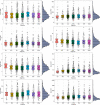Exploring the links among peripheral immunity, biomarkers, cognition, and neuroimaging in Alzheimer's disease
- PMID: 38124758
- PMCID: PMC10730778
- DOI: 10.1002/dad2.12517
Exploring the links among peripheral immunity, biomarkers, cognition, and neuroimaging in Alzheimer's disease
Abstract
Introduction: We analyzed relationships among peripheral immunity markers, cognition, Alzheimer's disease (AD)-related biomarkers, and neuroimaging to understand peripheral immunity involvement in AD.
Methods: Peripheral immunity markers were assessed in AD, non-AD neurodegenerative disorders, and controls, examining their connections with cognition, AD-related biomarkers, and neuroimaging using multiple regression models.
Results: The study included 1579 participants. Higher levels of white blood cell, neutrophil, monocyte, neutrophil-to-lymphocyte ratio (NLR), platelet-to-lymphocyte ratio (PLR), systemic immune-inflammation index (SII), and lower lymphocyte-to-monocyte ratio (LMR) were associated with cognitive decline and more severe anxiety and depression. The impact of lower LMR, lymphocyte count, and higher NLR on cognitive decline is mediated through cerebrospinal fluid amyloid beta (Aβ) levels. Additionally, increased PLR, NLR, and SII were associated with brain atrophy and hippocampal Aβ deposition (amyloid positron emission tomography).
Discussion: Peripheral immunity markers offer a non-invasive and cost-effective means of studying AD-related pathophysiological changes, providing valuable insights into its pathogenesis and treatment.
Highlights: Peripheral immunity markers linked to cognitive decline and anxiety/depression.Low LMR, LYM, and high NLR linked to reduced CSF Aβ, impacting cognition.High PLR, NLR, SII associated with brain atrophy and hippocampal Aβ deposition.
Keywords: Alzheimer's disease; amyloid beta; cerebrospinal fluid; cognition; neuroimage; peripheral immunity.
© 2023 The Authors. Alzheimer's & Dementia: Diagnosis, Assessment & Disease Monitoring published by Wiley Periodicals LLC on behalf of Alzheimer's Association.
Conflict of interest statement
The authors declare no competing interests. Author disclosures are available in the supporting information.
Figures




References
-
- 2021 Alzheimer's disease facts and figures. Alzheimers Dement. 2021;17:327‐406. - PubMed
LinkOut - more resources
Full Text Sources
